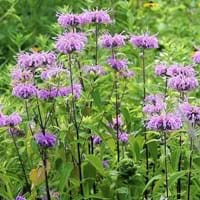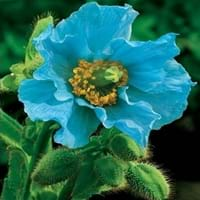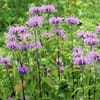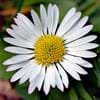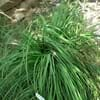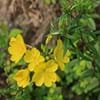Life Span
Perennial
Perennial
Origin
North America, Northeastern United States, Mid-Atlantic United States, Southeastern United States, North-Central United States, Central United States, South-Central United States, Texas, Canada
Southern Asia
Types
Monarda fistulosa brevis, Monarda fistulosa fistulosa, Monarda fistulosa mollis
Not Available
Number of Varieties
Not Available
Habitat
Thickets, Woodland edges
Mountains
USDA Hardiness Zone
Not Available
Not Available
Sunset Zone
Not Available
A1, A2, A3, 1b, 2a, 2b, 3a, 3b, 4, 5, 6, 17
Habit
Clump-Forming
Upright/Erect
Flower Color
Not Available
Blue, Rose
Flower Color Modifier
Bicolor
Bicolor
Fruit Color
Not Available
Green, Tan
Leaf Color in Spring
Not Available
Green, Blue Green
Leaf Color in Summer
Not Available
Green, Blue Green
Leaf Color in Fall
Not Available
Green, Blue Green
Leaf Color in Winter
Light Green
Light Green
Leaf Shape
Lance shaped
Oval with toothed margin
Plant Season
Spring, Summer
Summer
Sunlight
Full Sun, Partial Sun
Partial Sun, Partial shade
Growth Rate
Medium
Medium
Type of Soil
Clay, Loam, Sand
Loam
The pH of Soil
Acidic, Neutral, Alkaline
Acidic, Neutral
Soil Drainage
Average
Well drained
Bloom Time
Not Available
Early Summer
Tolerances
Drought, Heat Tolerance, Sun
Cold climate
Where to Plant?
Ground
Ground
How to Plant?
Seedlings
Divison, From bulbs, From Rhizomes, Seedlings
Plant Maintenance
Medium
Not Available
Watering Requirements
Medium
Do not let dry out between waterings, Requires consistently moist soil
In Summer
Lots of watering
Lots of watering
In Spring
Moderate
Moderate
In Winter
Average Water
Average Water
Soil pH
Acidic, Neutral, Alkaline
Acidic, Neutral
Soil Type
Clay, Loam, Sand
Loam
Soil Drainage Capacity
Average
Well drained
Sun Exposure
Full Sun, Partial Sun
Partial Sun, Partial shade
Pruning
Cut or pinch the stems, Remove damaged leaves, Remove dead branches, Remove dead flowers, Remove dead leaves, Remove deadheads
In late autumn, Remove damaged leaves, Remove dead branches, Remove dead leaves
Fertilizers
All-Purpose Liquid Fertilizer
Balanced liquid fertilizer monthly
Pests and Diseases
Powdery mildew, Rust
Downy mildew, Slugs, Snails
Plant Tolerance
Drought, Heat Tolerance, Sun
Cold climate
Flower Petal Number
Not Available
Single
Fragrant Bark/Stem
Yes
No
Foliage Texture
Not Available
Not Available
Foliage Sheen
Not Available
Not Available
Attracts
Bees, Hummingbirds
Bees, Birds, Butterflies
Allergy
Not Available
Not Available
Aesthetic Uses
Beautification, Cottage Garden, Showy Purposes
Beautification, Bouquets, Cottage Garden, Showy Purposes
Beauty Benefits
Skin inflammation, Skin Problems
Not Available
Edible Uses
Yes
Not Available
Environmental Uses
Air purification
Not Available
Medicinal Uses
Antiseptic, Carminative, Diaphoretic, Diuretic, Gastrointestinal disorders
Analgesic, Mild sedative
Part of Plant Used
Flowers, Leaves, Stem
Flowers
Other Uses
Added to salads, Used as a flavouring in food, Used as a potherb, Used as Ornamental plant
Employed in herbal medicine
Used As Indoor Plant
No
No
Used As Outdoor Plant
Yes
Yes
Garden Design
Cutflower, Edible, Mixed Border, Wildflower
Feature Plant, Mixed Border
Botanical Name
MONARDA fistulosa
MECONOPSIS betonicifolia
Common Name
Wild Bergamot, bee balm
Himalayan Blue Poppy
In Hindi
Wild Bergamot
हिमालय ब्लू पोस्ता
In German
Wilde Bergamotte
Himalaya Blue Poppy
In French
bergamote sauvage
Himalaya pavot bleu
In Spanish
bergamota silvestre
Amapola azul del Himalaya
In Greek
άγρια Περγαμόντο
Himalayan μπλε παπαρούνας
In Portuguese
Bergamota selvagem
Himalayan Blue Poppy
In Polish
Dziki Bergamot
Himalayan niebieski mak
In Latin
Wild Bergamot
Blue Himalayan Poppy
Phylum
Magnoliophyta
Magnoliophyta
Class
Magnoliopsida
Magnoliopsida
Order
Lamiales
Ranunculales
Family
Lamiaceae
Papaveraceae
Clade
Angiosperms, Asterids, Eudicots
Angiosperms, Eudicots
Tribe
Mentheae
Not Available
Subfamily
Nepetoideae
Not Available
Season and Care of Wild Bergamot and Himalayan Blue Poppy
Season and care of Wild Bergamot and Himalayan Blue Poppy is important to know. While considering everything about Wild Bergamot and Himalayan Blue Poppy Care, growing season is an essential factor. Wild Bergamot season is Spring and Summer and Himalayan Blue Poppy season is Spring and Summer. The type of soil for Wild Bergamot is Clay, Loam, Sand and for Himalayan Blue Poppy is Loam while the PH of soil for Wild Bergamot is Acidic, Neutral, Alkaline and for Himalayan Blue Poppy is Acidic, Neutral.
Wild Bergamot and Himalayan Blue Poppy Physical Information
Wild Bergamot and Himalayan Blue Poppy physical information is very important for comparison. Wild Bergamot height is 90.00 cm and width 45.70 cm whereas Himalayan Blue Poppy height is 90.00 cm and width 45.70 cm. The color specification of Wild Bergamot and Himalayan Blue Poppy are as follows:
Wild Bergamot flower color: Not Available
Wild Bergamot leaf color: Not Available
Himalayan Blue Poppy flower color: Blue and Rose
- Himalayan Blue Poppy leaf color: Green and Blue Green
Care of Wild Bergamot and Himalayan Blue Poppy
Care of Wild Bergamot and Himalayan Blue Poppy include pruning, fertilizers, watering etc. Wild Bergamot pruning is done Cut or pinch the stems, Remove damaged leaves, Remove dead branches, Remove dead flowers, Remove dead leaves and Remove deadheads and Himalayan Blue Poppy pruning is done In late autumn, Remove damaged leaves, Remove dead branches and Remove dead leaves. In summer Wild Bergamot needs Lots of watering and in winter, it needs Average Water. Whereas, in summer Himalayan Blue Poppy needs Lots of watering and in winter, it needs Average Water.
